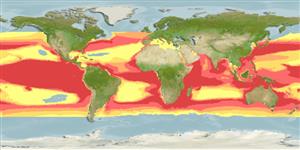Common names from other countries
Пластиножаберные (акулы и скаты) (sharks and rays) >
Myliobatiformes (Stingrays) >
Dasyatidae (Stingrays) > Dasyatinae
Etymology: Pteroplatytrygon: Greek, pteron = wing, fin + Greek,platys = flat + Greek, trygon = a sting ray (Ref. 45335); violacea: From the Latin 'viola' meaning violet..
More on author: Bonaparte.
Environment: milieu / climate zone / depth range / distribution range
экология
морской; пределы глубины 1 - 381 m (Ref. 58302), usually 1 - 100 m (Ref. 55209). Subtropical; 52°N - 50°S, 180°W - 180°E (Ref. 55209)
Probably cosmopolitan in tropical and subtropical seas. Eastern Pacific: Reported from Vancouver (Ref. 11980), from California (USA), Baja California (Mexico) to Chile, and the Galapagos Is. (Ref. 9068). Western Atlantic (Ref. 7251). Eastern Atlantic: Southeastern coasts of the Mediterranean and off Sicily; Reported from Cape Verde (Ref. 34514). Indian Ocean.
Length at first maturity / Size / Вес / Возраст
Maturity: Lm 45.0, range 40 - 50 cm
Max length : 96.0 cm WD самец/пол неопределен; (Ref. 48844); common length : 80.0 cm WD самец/пол неопределен; (Ref. 9254)
A thick, dark stingray with a broadly rounded snout and an angular pectoral disc; tail less than twice body length with a long lower caudal finfold ending far in front of tail tip, but with no upper finfold; disc without thorns; usually 1 extremely long sting on tail; eyes do not protrude (Ref. 5578). Uniformly violet, purple, or dark blue-green dorsally and ventrally (Ref. 3263). No prominent markings (Ref. 3263).
Found in open, tropical and warm temperate waters usually in the first 100 m. Possibly the only totally pelagic member of the family (Ref. 6871). Feeds on coelenterates (including medusae), squid, decapod crustaceans, and fish. Ovoviviparous (Ref. 50449). Venomous spine on tail. Common catch of the pelagic tuna (and shark) longline and gillnet fisheries (drift, Ref. 75025) operating throughout the region (Ref. 58048); also by purse-seine and bottom trawls (Ref. 75025). Utilized for its meat and sometimes cartilage (Ref.58048). Total length 110 TL (80 cm WD) (Ref. 9254).
Exhibit ovoviparity (aplacental viviparity), with embryos feeding initially on yolk, then receiving additional nourishment from the mother by indirect absorption of uterine fluid enriched with mucus, fat or protein through specialised structures (Ref. 50449). Distinct pairing with embrace (Ref. 205). With 2 (Ref.58048) to 9 young born at 15-25 cm WD (Ref. 26346); after a gestation period of 4 months (Ref.58048).
Compagno, L.J.V., 1999. Checklist of living elasmobranchs. p. 471-498. In W.C. Hamlett (ed.) Sharks, skates, and rays: the biology of elasmobranch fishes. Johns Hopkins University Press, Maryland. (Ref. 35766)
Статус Красного Списка МСОП (Ref. 130435)
CITES (Ref. 128078)
Not Evaluated
Использование человеком
рыболовство: коммерческий
дополнительная информация
инструменты
Специальные отчеты
Скачать в формате XML
ресурсы в Интернет
Estimates based on models
Preferred temperature (Ref.
115969): 12 - 28.6, mean 24.8 (based on 5148 cells).
Phylogenetic diversity index (Ref.
82804): PD
50 = 1.0000 [Uniqueness, from 0.5 = low to 2.0 = high].
Bayesian length-weight: a=0.00646 (0.00265 - 0.01571), b=3.06 (2.86 - 3.26), in cm Total Length, based on LWR estimates for this (Sub)family-body shape (Ref.
93245).
Trophic level (Ref.
69278): 4.4 ±0.54 se; based on food items.
устойчивость к внешним воздействиям (Ref.
120179): очень низкий, минимальное время удвоения популяции более 14 лет (K=0.18 (captivity); Fec=1-9 (could probably have 2 litters per year)).
Fishing Vulnerability (Ref.
59153): High vulnerability (63 of 100).
